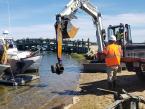On April 7, 1945, a group of American Helldivers and Avengers took off from aircraft carriers stationed near the coast of Okinawa and scored direct hits on the Yamato, the largest battleship in the world at the time and the pride of the Japanese navy. The sinking of the Yamato played a significant role in the Pacific theatre during World War II. For months, American naval forces had been battling highly trained Japanese pilots and facing a continuous rush of kamikaze strikes on its battleships and carriers.
The late Harvey Ewing, a former longtime resident of Edgartown and well-known newspaper reporter on the Vineyard, was one of the rear-seat tailgunners that day, part of a squadron of six Yorktown Avengers. The battle was recounted in The Carrier War by Time-Life Books, and Harvey is quoted in an excerpt below.
Exactly 70 years to the day after that battle, Mr. Ewing’s son, Steve, stopped by the Gazette office to share some memories of his father. He brought with him some of his father’s aviator logbooks, still in good shape, and carrying his meticulous notes of those days. Harvey Ewing died in 1995. Steve Ewing’s comments follow:
In 1945, my dad, Harvey Ewing, was a 21-year-old tail gunner in a torpedo bomber in the South Pacific. On April 7 his squadron of planes were among those that scored torpedo hits on the Japanese super battleship Yamato. Because of this attack the ship foundered and sunk that day.
Dad didn’t talk much about the war but he received The Distinguished Flying Cross for his role in that mission. Harvey kept the daily logbook for his flight crew and recorded the event simply as: “Torpedo hit Yamato.”
I remember the first time I dug out his logbooks and started to page through them. I soon realized these one-line entries often recorded significant days in history. They also coldly chronicled a part of my father’s young adulthood. In his early 20s, almost every day, he would settle into his tail gunner seat, take off from an aircraft carrier and fly into extraordinary danger over the South Pacific.
He returned to Fairhaven a decorated war hero. He graduated from Boston University, on the GI Bill, with a degree in journalism. In Boston, he met my mom, Jo-Ann, while she was at secretarial school. They were married in 1951 and later moved to Martha’s Vineyard, where Jo’s parents had a house. Harvey had accepted the position of bureau chief covering the Island for the New Bedford Standard Times. This was a new position as the ferry to the Vineyard ran from New Bedford the paper was very popular here.
My dad was a fairly passive guy. He did a lot of fishing but he never hunted or had anything to do with guns after the war. But 70 years ago, like so many young men, he climbed into that plane, flew into hell and did what he had to do, without asking for anything in return. I am so proud of my dad.
From The Carrier War, part of the Epic of Flight series, by Time-Life Books:
The port side of the ship was taking a savage beating. After two more torpedo hits, the Yamato developed a slight list; it could not be corrected by counterflooding, because many damage-control personnel had been killed or wounded. Smoke rose from the great battleship, and she gradually began to lose speed. A damaged rudder held her in a lazy turn to port. The American aircraft kept coming, wave upon wave of them, scoring hit after hit. “From near the funnel,” recalled Ensign Yoshida, “black smoke was rising in great puffs. There was a sudden increase in our list, and speed fell off to only seven knots! Now we were easy prey to the planes. As though awaiting this moment, the enemy came plunging through the clouds to deliver the coup de grace.” As his captain shouted “Hold on, men!” Yoshida lay down on the deck of the bridge; “I braced myself to withstand the shocks!”
The planes that Yoshida saw were six Yorktown Avengers commanded by Lieutenant Thomas Stetson. One of the squadron’s rear-seat gunners, Harvey Ewing, held his breath as he neared the ship. “I could see bursts of antiaircraft fire all around the plane as we made the run,” he said, “and to say I was scared would be an understatement. We dropped the fish and pulled up on one wing over the Yamato and seemed to hang there for minutes as the ship was firing every gun it had, including its 18-inch rifles, at the planes following us in.”
At least four torpedoes found their mark. “Great columns of water,” Yoshida said, “suddenly rose high into the air on the port side amidships.” As the Yamato shuddered from the explosions, the sea cascaded into the fresh holes in her side. “The horizon seemed to take on a mad new angle. Dark waves splattered and reached for us as the stricken ship heeled to the incredible list of 80 degrees!” The Yamato turned turtle and went under at 2:23 p.m. Yoshida heard “the blast, rumble and shock of compartments bursting from air pressure and exploding magazines already submerged.” He was one of only 269 survivors of the Yamato’s complement of 2,767.
The battleship had plenty of company on the ocean floor that afternoon. The cruiser Yahagi and four of the destroyers that had escorted the Yamato into battle also escorted her to the bottom. The remaining four destroyers limped back to Japan, having sustained varying degrees of damage. Almost 3,700 Japanese officers and men were killed, at a cost to Admiral Mitscher of only 10 aircraft. If the story of the shift of power at sea from once-mighty dreadnoughts to aircraft carriers needed a final chapter, it was written that afternoon as the Yamato went down.








Comments (9)
Comments
Comment policy »